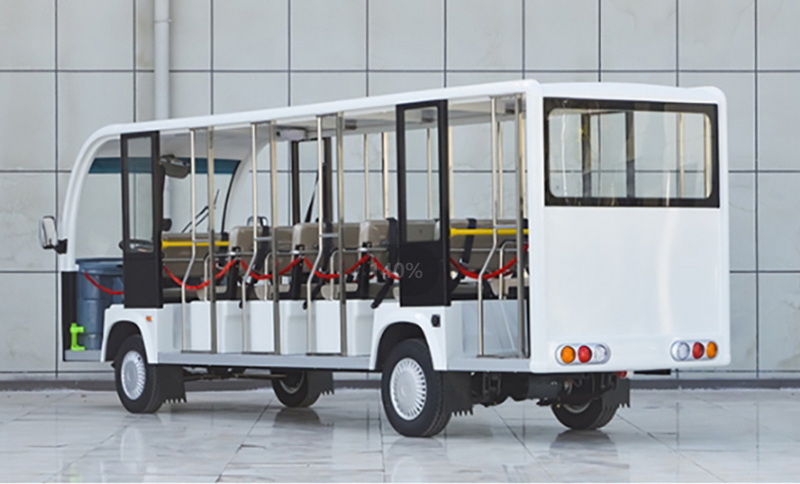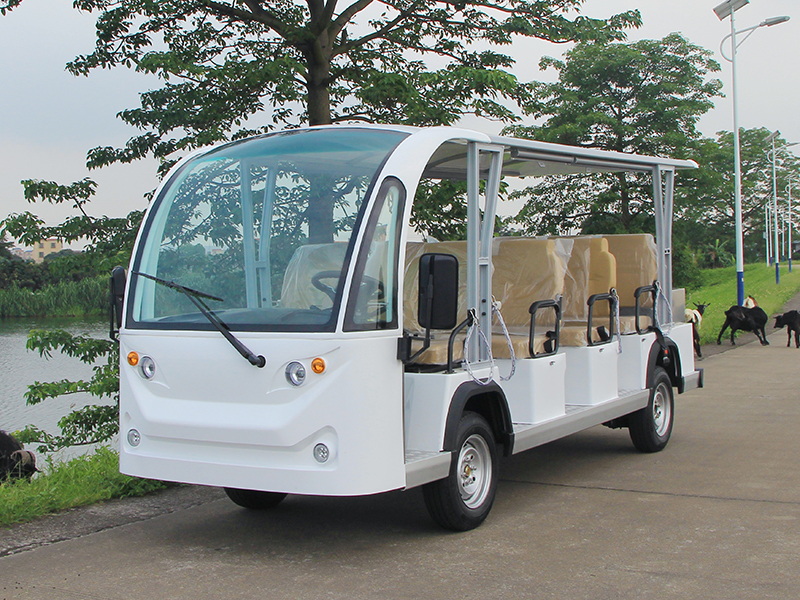Content Menu
● Introduction to Private Label Electric Sightseeing Buses
● Key Benefits of a Private Label Electric Sightseeing Bus
>> 1. Environmental Sustainability
>> 2. Customization and Branding
>> 3. Cost Efficiency
>> 4. Passenger Comfort and Accessibility
>> 5. Safety Features
>> 6. Versatility and Range of Models
● Technical Specifications and Features of Typical Private Label Electric Sightseeing Buses
● Maintenance and Operational Considerations
● Integration with Smart City and Tourism Technologies
● Economic and Social Impact
● Conclusion
● FAQ
>> 1. What is a private label electric sightseeing bus?
>> 2. How long can these electric buses operate on a single charge?
>> 3. Are private label electric sightseeing buses suitable for all types of terrain?
>> 4. What safety features are included in these buses?
>> 5. How customizable are private label electric sightseeing buses?
Electric sightseeing buses are transforming the way cities offer tours and transport visitors. A Private Label Electric Sightseeing Bus takes this innovation further by allowing businesses to customize and brand their electric buses, combining environmental sustainability with unique marketing opportunities. This article explores the numerous benefits of owning and operating a private label electric sightseeing bus, supported by detailed specifications, features, and practical insights.

Introduction to Private Label Electric Sightseeing Buses
A Private Label Electric Sightseeing Bus is an electric-powered vehicle designed specifically for tourist transport and sightseeing tours. Unlike generic models, private label buses are customized to meet the specific needs of operators, including branding, seating capacity, and onboard amenities. These buses are environmentally friendly, quiet, and offer a comfortable ride, making them ideal for urban tours, resorts, parks, and corporate events.
The rise of eco-conscious tourism and the increasing demand for sustainable transport solutions have accelerated the adoption of electric sightseeing buses worldwide. Private label options provide a competitive edge by allowing businesses to differentiate themselves through unique designs and features tailored to their clientele.
Key Benefits of a Private Label Electric Sightseeing Bus
1. Environmental Sustainability
Electric sightseeing buses produce zero emissions, significantly reducing the carbon footprint compared to diesel or petrol buses. This aligns with global efforts to promote green transportation and helps cities and businesses meet environmental regulations and goals. By adopting a private label electric sightseeing bus, operators contribute to cleaner air quality, reduced noise pollution, and a healthier urban environment.
Moreover, many cities are introducing incentives such as tax breaks, subsidies, or preferential operating permits for electric vehicles, making private label electric sightseeing buses an economically attractive choice for tour operators and municipalities alike.
2. Customization and Branding
One of the standout advantages of a private label electric sightseeing bus is the ability to fully customize the vehicle to reflect the operator's brand identity. This includes:
- Exterior Design: Custom paint jobs, logos, and thematic wraps that make the bus instantly recognizable and memorable.
- Interior Layout: Flexible seating arrangements, from open-air configurations to enclosed cabins, tailored to the type of tours offered.
- Onboard Amenities: Installation of audio-visual equipment, Wi-Fi, charging ports, and climate control systems to enhance passenger experience.
- Unique Features: Options such as panoramic glass roofs, retractable canopies, or LED lighting to create a distinctive ambiance.
This level of customization not only improves customer engagement but also helps operators stand out in a competitive market, attracting more tourists and increasing revenue potential.
3. Cost Efficiency
Operating a private label electric sightseeing bus can result in significant cost savings over time. Key factors include:
- Lower Fuel Costs: Electricity is generally cheaper than diesel or petrol, and electric buses have higher energy efficiency.
- Reduced Maintenance: Electric motors have fewer moving parts than combustion engines, resulting in less wear and tear and lower maintenance expenses.
- Long Battery Life: Advances in battery technology, such as lithium-ion cells, offer extended lifespans and fast charging capabilities, minimizing downtime.
- Government Incentives: Many regions provide financial incentives for electric vehicle adoption, helping offset initial investment costs.
When combined, these factors contribute to a lower total cost of ownership, making private label electric sightseeing buses a financially sound investment for tour operators.
4. Passenger Comfort and Accessibility
Private label electric sightseeing buses prioritize passenger comfort and accessibility, which are critical for a positive tour experience. Features often include:
- Low-Floor Design: Facilitates easy boarding and disembarking, especially for elderly passengers, families with strollers, and people with disabilities.
- Quiet Operation: Electric motors operate silently, allowing passengers to enjoy conversations and guided tours without engine noise interference.
- Climate Control: Air conditioning and heating systems ensure comfort in various weather conditions.
- Ergonomic Seating: Comfortable, adjustable seats with ample legroom enhance the ride quality.
- Large Windows: Panoramic windows or open sides provide unobstructed views of sightseeing attractions.
These thoughtful design elements ensure that passengers have a safe, enjoyable, and memorable experience, encouraging repeat business and positive reviews.
5. Safety Features
Safety is paramount in public transport, and private label electric sightseeing buses come equipped with modern safety systems, including:
- Anti-lock Braking System (ABS): Prevents wheel lock-up during sudden braking, maintaining steering control.
- Emergency Brakes: Provide rapid stopping power in critical situations.
- Seat Belts: Enhance passenger protection during transit.
- Collision Warning Systems: Alert drivers to potential hazards, reducing accident risks.
- Fire Suppression Systems: Protect against electrical fires, particularly important in battery-powered vehicles.
- CCTV and Monitoring: Onboard cameras improve security and allow operators to monitor passenger behavior.
By integrating these features, private label electric sightseeing buses meet or exceed safety standards, providing peace of mind for operators and passengers alike.
6. Versatility and Range of Models
Private label electric sightseeing buses come in a wide range of sizes and configurations, allowing operators to select the best fit for their operational environment:
- Mini and Compact Models: Ideal for narrow streets, pedestrian zones, and small groups.
- Standard Single-Deck Buses: Offer moderate seating capacity with flexible layouts.
- Double-Decker Buses: Provide elevated panoramic views, perfect for city tours with scenic landmarks.
- Open-Top Variants: Enhance the sightseeing experience in pleasant weather conditions.
This versatility means private label electric sightseeing buses can be deployed in diverse settings such as historic city centers, theme parks, university campuses, resorts, and large event venues.

Technical Specifications and Features of Typical Private Label Electric Sightseeing Buses
| Feature | Description |
| Motor Power | 7.5 kW to 13.5 kW DC or AC systems |
| Battery Type | Lithium-ion, Lead-acid, or PP batteries |
| Passenger Capacity | 4 to 23 seats |
| Max Speed | 25 to 40 km/h |
| Range | 80 to 120 km per charge |
| Dimensions (L×W×H) | Approx. 5900×1960×2210 mm (varies by model) |
| Turning Radius | 5 to 8.5 meters |
| Braking System | Hydraulic brakes with ABS |
| Additional Features | Air conditioning, Wi-Fi, reclining seats, safety belts |
These specifications highlight the balance of performance, comfort, and safety that private label electric sightseeing buses offer. Operators can often choose specific configurations to optimize for range, passenger load, or terrain.
Maintenance and Operational Considerations
Regular inspections and scheduled maintenance are crucial for the longevity and safety of electric sightseeing buses. Key maintenance tasks include:
- Battery Health Monitoring and Balancing: Ensures optimal performance and extends battery life by preventing overcharging or deep discharging.
- Brake System Checks: Regular inspection of hydraulic brakes and ABS components to maintain safety standards.
- Tire and Suspension Inspections: To ensure smooth rides and prevent premature wear.
- Air Conditioning and Cooling System Maintenance: Keeps passengers comfortable and prevents overheating of electrical components.
- Software Updates: For motor controllers, battery management systems, and onboard multimedia equipment to improve efficiency and functionality.
Proactive maintenance reduces downtime and extends the bus's operational life, making private label electric sightseeing buses a reliable investment. Additionally, many manufacturers offer comprehensive after-sales support and training for operators to manage their fleets effectively.
Integration with Smart City and Tourism Technologies
Private label electric sightseeing buses can be integrated into broader smart city and tourism ecosystems. Features such as GPS tracking, real-time passenger information systems, and mobile app connectivity allow operators to:
- Optimize Routes: Using traffic data and passenger demand analytics.
- Provide Real-Time Updates: Passengers can track bus locations and arrival times via smartphone apps.
- Enhance Safety: Through remote diagnostics and emergency response coordination.
- Collect Data: On passenger numbers, preferences, and feedback to improve service quality.
This integration supports sustainable urban mobility goals and enriches the visitor experience by making sightseeing tours more efficient and responsive.
Economic and Social Impact
Investing in private label electric sightseeing buses can have positive economic and social impacts:
- Job Creation: From manufacturing and customization to operation and maintenance.
- Tourism Growth: Enhanced tours attract more visitors, boosting local businesses.
- Community Engagement: Promotes awareness of sustainability and supports local culture through tailored tour content.
- Reduced Noise Pollution: Improves quality of life for residents in busy tourist areas.
By choosing private label electric sightseeing buses, operators contribute to building greener, smarter, and more vibrant communities.
Conclusion
A Private Label Electric Sightseeing Bus offers numerous advantages, including environmental friendliness, cost savings, enhanced passenger comfort, and customizable branding opportunities. These buses are versatile, available in various sizes and configurations, and equipped with modern safety and comfort features. For businesses and cities aiming to provide sustainable, efficient, and attractive sightseeing transport, private label electric sightseeing buses represent a smart and forward-thinking choice. Their integration with smart technologies and positive economic impact further solidify their role as a key asset in modern tourism and urban mobility.

FAQ
1. What is a private label electric sightseeing bus?
A private label electric sightseeing bus is a customizable electric bus designed for tourist transport, allowing operators to brand and tailor the vehicle to their specific needs.
2. How long can these electric buses operate on a single charge?
Depending on the model and battery type, ranges typically vary from 80 km to 120 km per full charge.
3. Are private label electric sightseeing buses suitable for all types of terrain?
They are best suited for urban and flat terrains but can handle moderate inclines (up to 15-20%) depending on motor power and design.
4. What safety features are included in these buses?
Common safety features include anti-lock braking systems, seat belts, emergency brakes, and collision warning systems.
5. How customizable are private label electric sightseeing buses?
Highly customizable, including exterior design, seating capacity, onboard amenities like Wi-Fi and air conditioning, and even battery and motor specifications to suit operational needs.










































